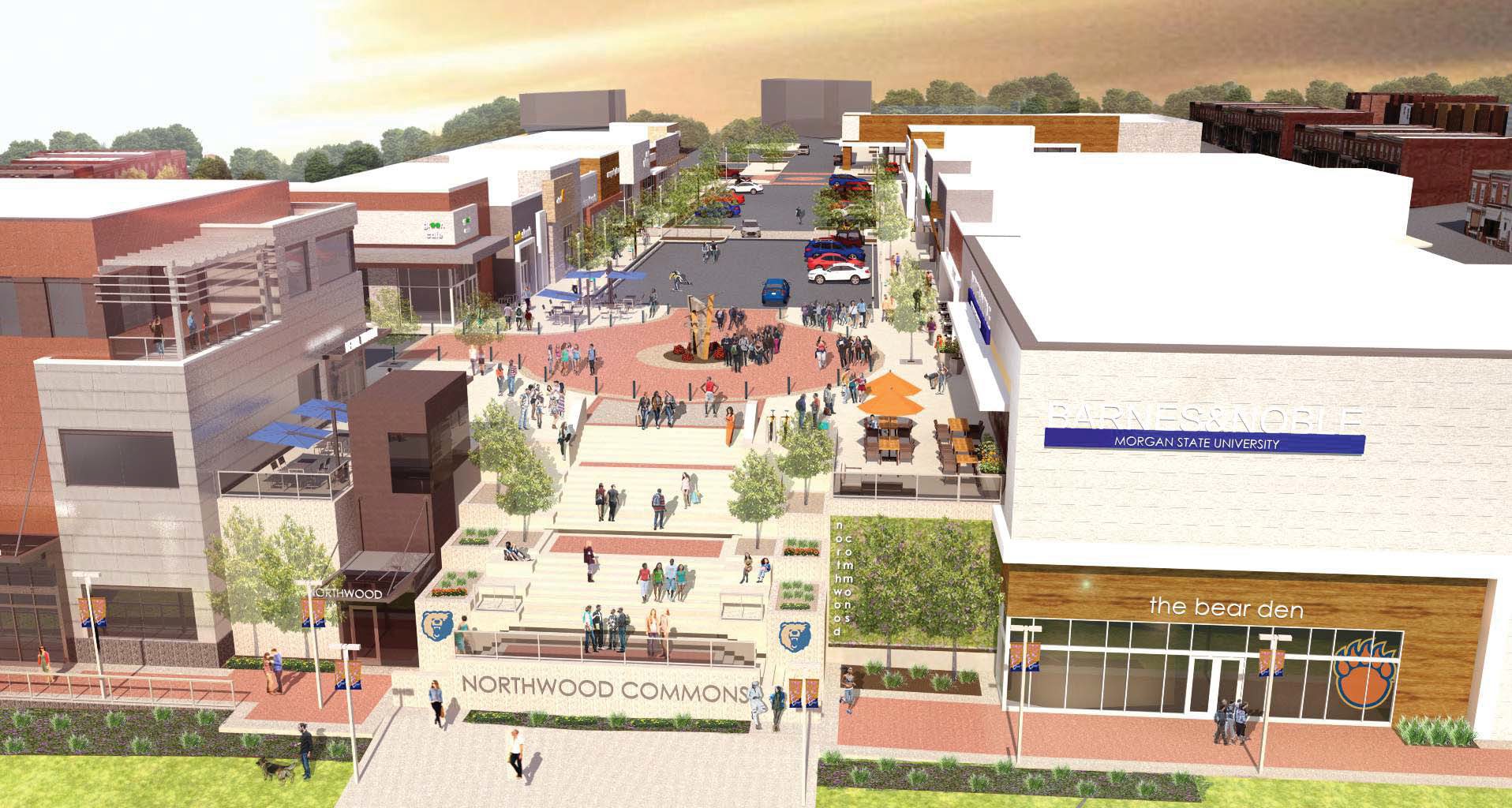In the midst of the pandemic and the ensuing turmoil in the retail sector, leasing agents for Northwood Commons were busy. The former Northwood Plaza had been struggling for decades and periodic talks about redevelopment plans never gained traction. Then MCB Real Estate crafted a plan to overhaul the property to create attractive architecture, high visibility and a pedestrian-friendly environment. And it planned to include Morgan State University in the revitalization.
“A major key to the success of this project was rethinking tenancy to not only serve the community but to serve the Morgan State student body as well,” said Drew Gorman, Principal at MCB Real Estate.
MCB secured a deal to include some Morgan State offices and a Barnes & Noble Campus Bookstore in the new, 100,000-square-foot property, and started signing other leases.

Designing Northwood Commons to serve both the neighborhood and Morgan State enabled MCB Real Estate to lease 80 percent of the space before construction began. Image courtesy of MCB Real Estate.
“This project was about 80 percent leased before we broke ground and that was during Covid,” said Peter Pinkard, Managing Partner. “We would get five to 10 phone calls a week about this project. We have some projects outside of the Baltimore area where if we get five calls in five years, that would be a lot.”
Pinkard and Gorman point to Northwood Commons and other projects, such as Yard 56, as evidence of continued, strong opportunities in Maryland’s retail market. However, in the wake of a pandemic and in the face of inflation and a possible recession, those opportunities are focused on very particular properties.
“Every shopping center and every intersection is its own ecosystem. Everyone looks at each retail site differently. That’s why everyone is so uber picky about where they go,” said John Schultz, Senior Vice President and Principal, Brokerage at MacKenzie Real Estate Services. Given recent and current challenges in the retail sector, “the scrutiny on spaces from tenants is at an all-time high because they just can’t afford to make a mistake in this environment.”
MacKenzie’s Q1 retail market report noted, “Retail tenants in the market are seeking Class A space and pad locations, and are showing a casual patience, waiting for the best option, the more favorable terms, and the right location for brand recognition.”
“Before Covid, you could probably get a few entrepreneurs to settle for B+ or B spaces. Now, companies are having more trouble leasing those less-than-perfect spaces,” Schultz said.
Consequently, CRE professionals need to hone their offerings in order to succeed in the retail sector.
“Over the past few years, we have invested in technology platforms to help us better understand and analyze consumers’ traffic and shopping patterns,” said Daniel Klein, President of Klein Enterprises. In addition, “we are evaluating some of our retail properties for the potential integration of multifamily.”
Those two efforts have delivered excellent results at some Klein properties. Marketplace at Fells Point – a mixed-use project with 159 apartments above 27,000 square feet of commercial space – has thrived on its own and “spurred the renovation of properties in the immediate area with additional residential above retail. It has been transformative in this area of the city,” Klein said.
In California, MD, Klein’s St. Mary’s Marketplace was strategically sited and designed to serve the community and attract a good mix of national retailers. Located on a prime intersection near Naval Air Station Patuxent River, thriving waterfront communities and a hub of high-tech jobs, the center attracted the first Harris Teeter in the region.
“As national tenants start to spring back into growth mode – and they have – they are fighting over A or A+ real estate and creating a price war for the really valuable retail real estate. By valuable, I mean it is zoned properly, highly visible, with easy access and creative co-tenancy,” Schultz said.
Owners of less-than-perfect retail properties still have ample prospects in the current market but will likely have to complete some upgrades to seize those opportunities.
“For decades, open air retail was thought to be a very capital free business. You built a center, tenants took care of the leases and every now and then you put on a new roof or parking surface,” Gorman said. “Retail competition has intensified and this is now a capital intensive business. You are going to have to invest in additional and attractive buildings, additional infrastructure to support more restaurants and drive-thru lanes, and better signage, visibility and merchandising. Retail is dynamic so you have to carefully curate the right mix of tenants.”
A few trends promise to drive new tenants to those improved open-air centers. Those include the decision of more online-only retailers to open brick and mortar stores, increased interest in apparel stores, the migration of medical services to retail strips, and heightened consumer demand for wellness and personal services providers. The expansion of ALDI and Lidl and tentative plans by Amazon to open some grocery stores in Maryland could also “provide a really good shot in the arm for some second-generation retail centers,” Schultz said.